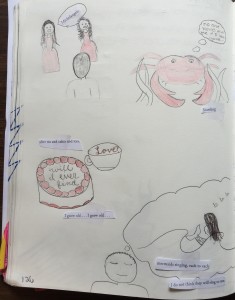In a classroom where visual literacy is explored, poetry is another ancient art form charged with potential. Good poems ask the reader to see and hear. From Emily Dickinson’s “I dwell in possibility” to Charles Bernstein’s “Of Time and the Line” poets see the poem as a vibrant opening of the possible.
The exercise of moving a poem to the page is not complicated. Too often we feel intimated by poetry. We worry about students not getting the sense. Consequently, we look for ‘easy’ poems where we understand every literary element. We can treat poems too mechanistically to the point of analyzing the life out of each line. Or choose poems we don’t think needs much interpretation, almost self evident. If poetry is an art of possibility, should it be for readers?
Throughout the year I choose different kinds of poems, depending on the class, their interests, grade level, and/or unit we are studying. I typically provide a copy of the poem to the class so we can work the text, annotating, writing, underlining, circling or doodling. I read the poem aloud, we have some class discussion, and I give some cultural context. I encourage students to observe, interpret, and respond. I make sure at some level they understand and experience the unique logic and beauty of poetry.
This last quarter we read T.S. Eliot’s The Love Song of J Alfred Prufrock and then I asked them to make a visual interpretation of the poem. After some basic discussion about components of composition — such as rule of thirds, the numerous ways the page can be divided to create effects, how placement of design, color, and words work to visually persuade — I asked them to make a visual reading of the poem using both text and the page in their journals. If these pages could sing, what would we hear?
–James Shivers


